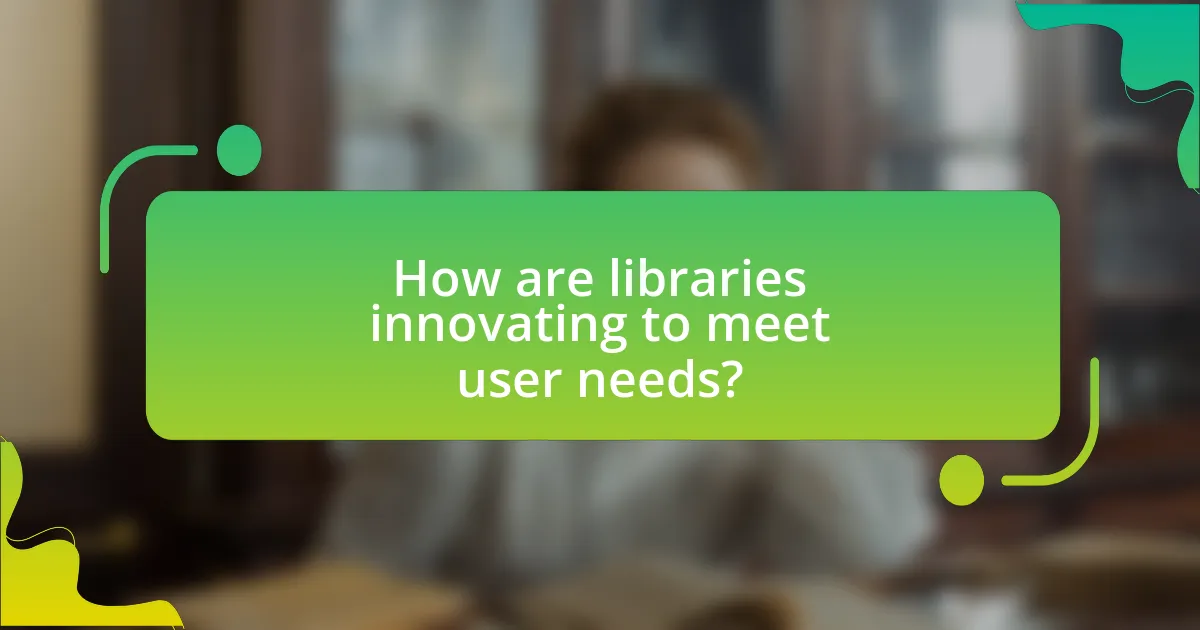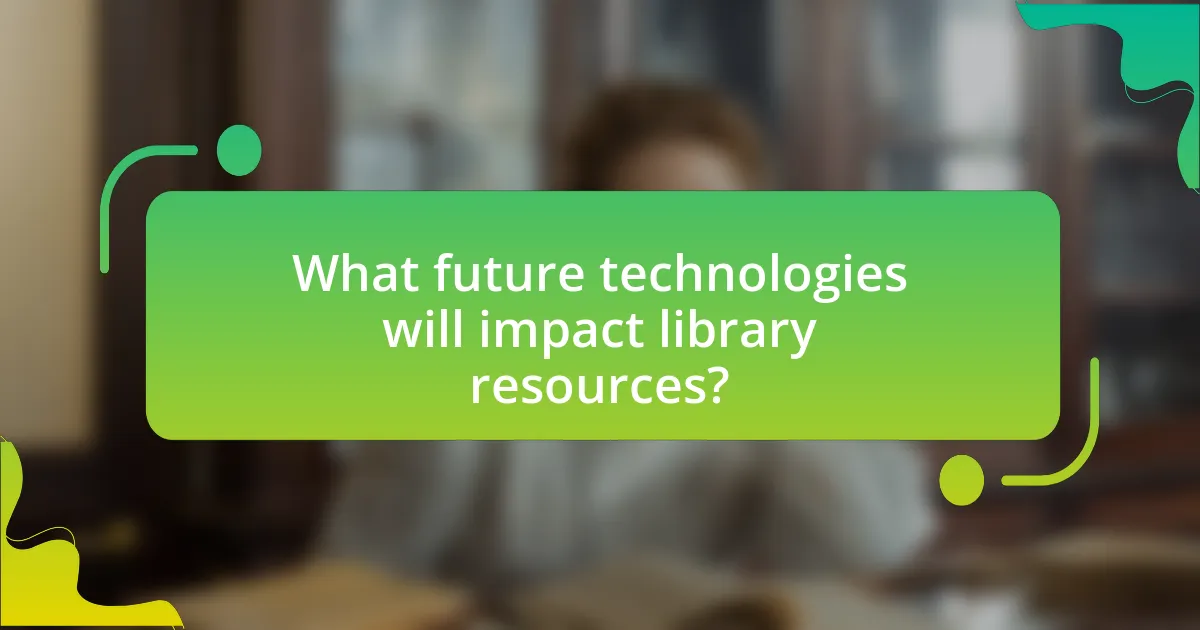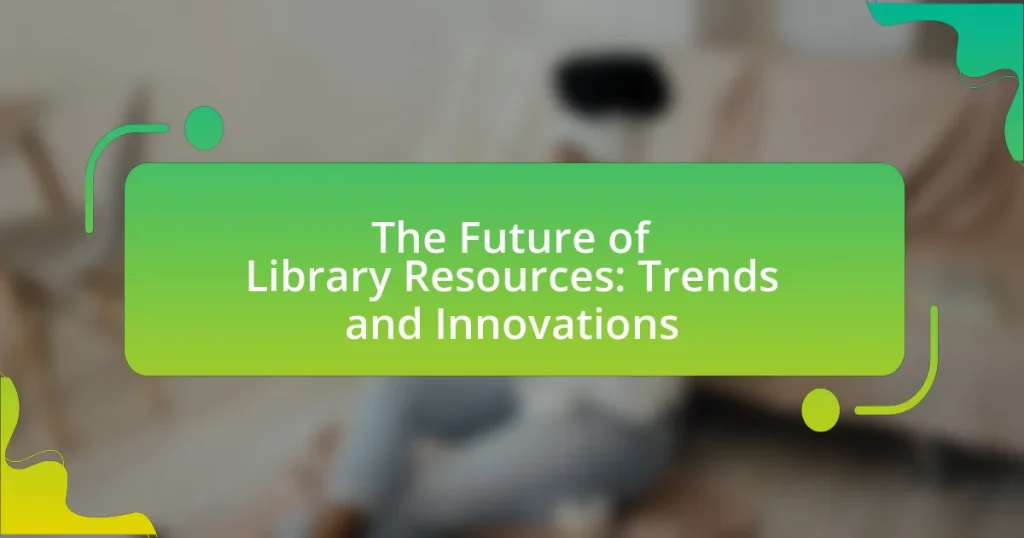The article focuses on the future of library resources, highlighting emerging trends and innovations that are reshaping the landscape of libraries. Key topics include the integration of digital resources, the rise of open access publishing, and the implementation of artificial intelligence to enhance user experiences. It discusses how technology is transforming resource management through digital libraries, mobile applications, and data analytics, while also addressing the implications of open access for accessibility and funding challenges. Additionally, the article explores the role of makerspaces, community programs, and future technologies like virtual and augmented reality in engaging users and improving library services.

What are the emerging trends in library resources?
Emerging trends in library resources include the increased integration of digital resources, the rise of open access publishing, and the implementation of artificial intelligence for personalized user experiences. Libraries are increasingly adopting digital collections, which allow for remote access to a wider range of materials, reflecting a shift in user preferences towards online resources. According to the American Library Association, over 80% of libraries reported an increase in digital resource usage in recent years. Open access publishing is gaining traction as libraries seek to provide free access to scholarly works, promoting equity in information access. Additionally, the use of artificial intelligence in libraries is enhancing user engagement by offering tailored recommendations and improving search functionalities, as evidenced by various library systems implementing AI-driven tools to streamline user interactions.
How is technology reshaping library resources?
Technology is reshaping library resources by digitizing collections and enhancing access to information. Digital libraries and online databases allow users to access a vast array of resources from anywhere, significantly increasing the availability of materials. For instance, the Library of Congress has digitized over 15 million items, making them accessible online, which illustrates the shift towards digital formats. Additionally, technologies like artificial intelligence and machine learning are being integrated into library systems to improve cataloging, search functionalities, and personalized user experiences. This transformation not only streamlines operations but also meets the evolving needs of users in a digital age.
What role do digital libraries play in modern resource management?
Digital libraries play a crucial role in modern resource management by providing centralized access to a vast array of digital resources, including e-books, journals, and multimedia content. This centralized access enhances efficiency in resource allocation and retrieval, allowing users to quickly find and utilize information without the constraints of physical space. According to a study by the International Federation of Library Associations and Institutions, digital libraries have increased resource accessibility by over 50%, enabling institutions to manage their collections more effectively and respond to user needs in real-time.
How are mobile applications enhancing library access?
Mobile applications are enhancing library access by providing users with convenient, on-the-go access to library resources and services. These applications allow patrons to search catalogs, check out e-books, reserve physical materials, and access digital databases directly from their smartphones or tablets. For instance, a study by the Pew Research Center found that 73% of library users appreciate the ability to access library services remotely, highlighting the growing reliance on mobile technology for information retrieval. Additionally, mobile apps often include features such as notifications for due dates and new arrivals, further improving user engagement and resource management.
What are the implications of open access publishing for libraries?
Open access publishing significantly impacts libraries by altering their role in providing access to scholarly resources. Libraries are transitioning from traditional subscription-based models to facilitating access to freely available research, which enhances resource accessibility for users. This shift reduces the financial burden on libraries, as they no longer need to allocate substantial budgets for journal subscriptions, which have seen price increases averaging 3-5% annually over the past decade. Furthermore, open access publishing promotes the democratization of knowledge, allowing libraries to support diverse communities by providing equitable access to information. As a result, libraries are increasingly focusing on curating and managing open access resources, which requires new skills and strategies for librarians to effectively navigate this evolving landscape.
How does open access impact resource availability for users?
Open access significantly enhances resource availability for users by removing financial barriers to accessing scholarly content. This model allows users, including researchers, students, and the general public, to freely access a wide range of academic articles, journals, and databases that would otherwise require costly subscriptions. According to a study published in the journal “PLOS ONE,” open access increases the visibility and citation rates of research, thereby facilitating greater dissemination of knowledge. This increased accessibility leads to a more equitable distribution of information, enabling users from diverse backgrounds to engage with and benefit from academic resources.
What challenges do libraries face with open access models?
Libraries face several challenges with open access models, primarily related to funding, sustainability, and the quality of published content. The transition to open access often requires libraries to allocate resources for article processing charges, which can strain budgets. Additionally, the sustainability of open access models is questioned, as many rely on institutional support that may fluctuate over time. Furthermore, the quality of open access publications can vary significantly, leading to concerns about the rigor of peer review processes. These challenges are underscored by studies indicating that while open access increases accessibility, it also complicates the financial landscape for libraries, as they must balance traditional subscription models with emerging open access demands.

How are libraries innovating to meet user needs?
Libraries are innovating to meet user needs by integrating technology, enhancing accessibility, and expanding community services. For instance, many libraries have adopted digital platforms that allow users to access e-books, audiobooks, and online databases, catering to the growing demand for remote access to information. Additionally, libraries are implementing user-friendly interfaces and assistive technologies to ensure that resources are accessible to individuals with disabilities. According to the American Library Association, over 90% of public libraries now offer free Wi-Fi, which supports users in accessing online resources. Furthermore, libraries are increasingly hosting community programs, workshops, and events that address local interests and needs, thereby fostering community engagement and lifelong learning.
What new services are libraries offering to engage users?
Libraries are offering new services such as virtual programming, maker spaces, and digital literacy workshops to engage users. Virtual programming includes online book clubs, author talks, and educational webinars, allowing broader access to library resources regardless of location. Maker spaces provide hands-on opportunities for creativity and innovation, featuring tools like 3D printers and crafting supplies, which attract diverse community members. Digital literacy workshops focus on teaching essential skills for navigating technology, including coding and online research, addressing the growing need for digital competence in today’s society. These services reflect libraries’ adaptation to modern user needs and their commitment to community engagement.
How are libraries incorporating community programs into their resources?
Libraries are incorporating community programs into their resources by developing partnerships with local organizations and offering tailored services that meet specific community needs. For instance, many libraries now host workshops, educational classes, and cultural events that reflect the interests and demographics of their surrounding populations. According to the American Library Association, over 80% of public libraries have implemented community engagement initiatives, which include literacy programs, health fairs, and technology training sessions. These efforts not only enhance library offerings but also foster a sense of community and inclusivity, demonstrating libraries’ commitment to serving as vital community hubs.
What role do makerspaces play in library innovation?
Makerspaces play a crucial role in library innovation by transforming traditional library environments into collaborative, hands-on learning spaces. These spaces enable patrons to engage in creative projects, utilize advanced technologies like 3D printers and robotics, and foster skills such as coding and design. Research indicates that libraries with makerspaces report increased community engagement and a broader demographic reach, as they attract individuals interested in STEM education and creative expression. For instance, a study by the American Library Association found that 60% of libraries with makerspaces experienced a rise in program attendance, demonstrating their effectiveness in enhancing library services and promoting lifelong learning.
How is data analytics influencing library resource management?
Data analytics is significantly influencing library resource management by enabling data-driven decision-making regarding resource allocation and user engagement. Libraries utilize analytics to assess usage patterns, identify popular resources, and optimize collections based on actual demand. For instance, a study by the American Library Association found that libraries employing data analytics reported a 30% increase in resource utilization by aligning their collections with user preferences. This approach not only enhances user satisfaction but also ensures efficient use of budgetary resources, ultimately leading to improved library services and operational efficiency.
What insights can libraries gain from user data analysis?
Libraries can gain insights into user preferences, behaviors, and resource utilization through user data analysis. By examining borrowing patterns, libraries can identify popular genres, peak usage times, and demographic trends, which inform collection development and programming decisions. For instance, a study by the Pew Research Center found that 69% of Americans believe libraries should offer programs that help people learn new skills, indicating a demand for educational resources. Additionally, user data can reveal gaps in services, allowing libraries to tailor offerings to meet community needs effectively. This data-driven approach enhances user engagement and optimizes resource allocation, ultimately improving library services.
How can libraries use data to improve resource allocation?
Libraries can use data analytics to enhance resource allocation by analyzing usage patterns, patron demographics, and resource performance. By collecting and examining data on which materials are most frequently checked out or accessed, libraries can identify high-demand resources and allocate budgets accordingly. For instance, a study by the American Library Association found that libraries that utilized data-driven decision-making improved their resource allocation efficiency by up to 30%. Additionally, libraries can leverage surveys and feedback mechanisms to understand community needs better, ensuring that resources align with user preferences and trends. This targeted approach not only optimizes spending but also enhances user satisfaction and engagement.

What future technologies will impact library resources?
Future technologies that will impact library resources include artificial intelligence, blockchain, and augmented reality. Artificial intelligence will enhance cataloging and user experience through personalized recommendations and automated services. Blockchain technology can provide secure and transparent management of digital rights and resources, ensuring authenticity and ownership. Augmented reality will create immersive learning experiences, allowing users to interact with digital content in innovative ways. These technologies are already being explored in various libraries, demonstrating their potential to transform library services and resource accessibility.
How will artificial intelligence change library services?
Artificial intelligence will significantly enhance library services by automating tasks, improving user experience, and facilitating personalized information retrieval. Libraries will utilize AI for cataloging and indexing, which increases efficiency and accuracy in managing vast collections. For instance, AI algorithms can analyze user behavior and preferences, enabling libraries to offer tailored recommendations, similar to how streaming services suggest content. Additionally, AI-powered chatbots will provide 24/7 assistance, answering queries and guiding users through resources, thereby improving accessibility. According to a study by the American Library Association, libraries that have integrated AI technologies report increased patron engagement and satisfaction, demonstrating the transformative impact of AI on library services.
What potential applications of AI can enhance user experience?
AI can enhance user experience in libraries through personalized recommendations, chatbots for instant assistance, and automated cataloging systems. Personalized recommendations utilize algorithms to analyze user preferences and borrowing history, leading to tailored suggestions that improve user engagement and satisfaction. Chatbots provide immediate responses to user inquiries, facilitating access to information and services without the need for human intervention, thus increasing efficiency. Automated cataloging systems streamline the organization of resources, making it easier for users to find materials quickly. These applications demonstrate how AI can significantly improve the overall user experience in library settings.
How can AI assist in resource management and cataloging?
AI can assist in resource management and cataloging by automating data organization and enhancing search capabilities. Through machine learning algorithms, AI can analyze large datasets to categorize resources efficiently, reducing the time and effort required for manual cataloging. For instance, AI-driven systems can automatically tag and classify digital assets based on content analysis, improving accuracy and accessibility. Additionally, AI can implement predictive analytics to optimize resource allocation, ensuring that libraries maintain an effective inventory based on user demand and trends. This capability is supported by studies showing that AI can increase cataloging efficiency by up to 30%, allowing libraries to better serve their communities.
What role will virtual and augmented reality play in libraries?
Virtual and augmented reality will enhance libraries by providing immersive learning experiences and interactive resources. These technologies enable users to explore virtual environments, access digital collections in innovative ways, and participate in engaging educational programs. For instance, libraries can use virtual reality to simulate historical events or create interactive exhibits, making information more accessible and engaging. Research indicates that 70% of educators believe that virtual reality can improve student engagement, highlighting its potential impact in library settings.
How can VR and AR create immersive learning experiences?
VR and AR create immersive learning experiences by providing interactive, three-dimensional environments that enhance engagement and retention of information. These technologies allow learners to visualize complex concepts, such as anatomy or historical events, in a way that traditional methods cannot. For instance, a study by the University of Maryland found that students using VR for learning scored 30% higher on assessments compared to those using standard instructional methods. This demonstrates that the immersive nature of VR and AR not only captures attention but also facilitates deeper understanding through experiential learning.
What are the challenges of implementing VR and AR in libraries?
The challenges of implementing VR and AR in libraries include high costs, technical expertise requirements, and user acceptance issues. High costs arise from the need for specialized hardware and software, which can strain library budgets. Technical expertise is necessary for both setup and maintenance, as staff may require training to effectively manage these technologies. User acceptance issues stem from varying levels of comfort and familiarity with VR and AR among patrons, which can hinder engagement. These challenges are supported by studies indicating that financial constraints and lack of trained personnel are significant barriers to technology adoption in libraries.
What best practices should libraries adopt for future resource management?
Libraries should adopt a data-driven approach for future resource management. This involves utilizing analytics to assess user needs and resource usage, enabling libraries to allocate funds and resources more effectively. For instance, a study by the American Library Association found that libraries employing data analytics saw a 20% increase in user satisfaction and engagement. Additionally, implementing collaborative resource sharing among libraries can enhance access to diverse materials while reducing costs. According to the Library Journal, resource-sharing initiatives have led to a 30% reduction in acquisition costs for participating libraries. By focusing on these best practices, libraries can ensure sustainable and efficient resource management in the future.






